TOYOTA RAV4 2006 Service Repair Manual
Manufacturer: TOYOTA, Model Year: 2006, Model line: RAV4, Model: TOYOTA RAV4 2006Pages: 2000, PDF Size: 45.84 MB
Page 1981 of 2000
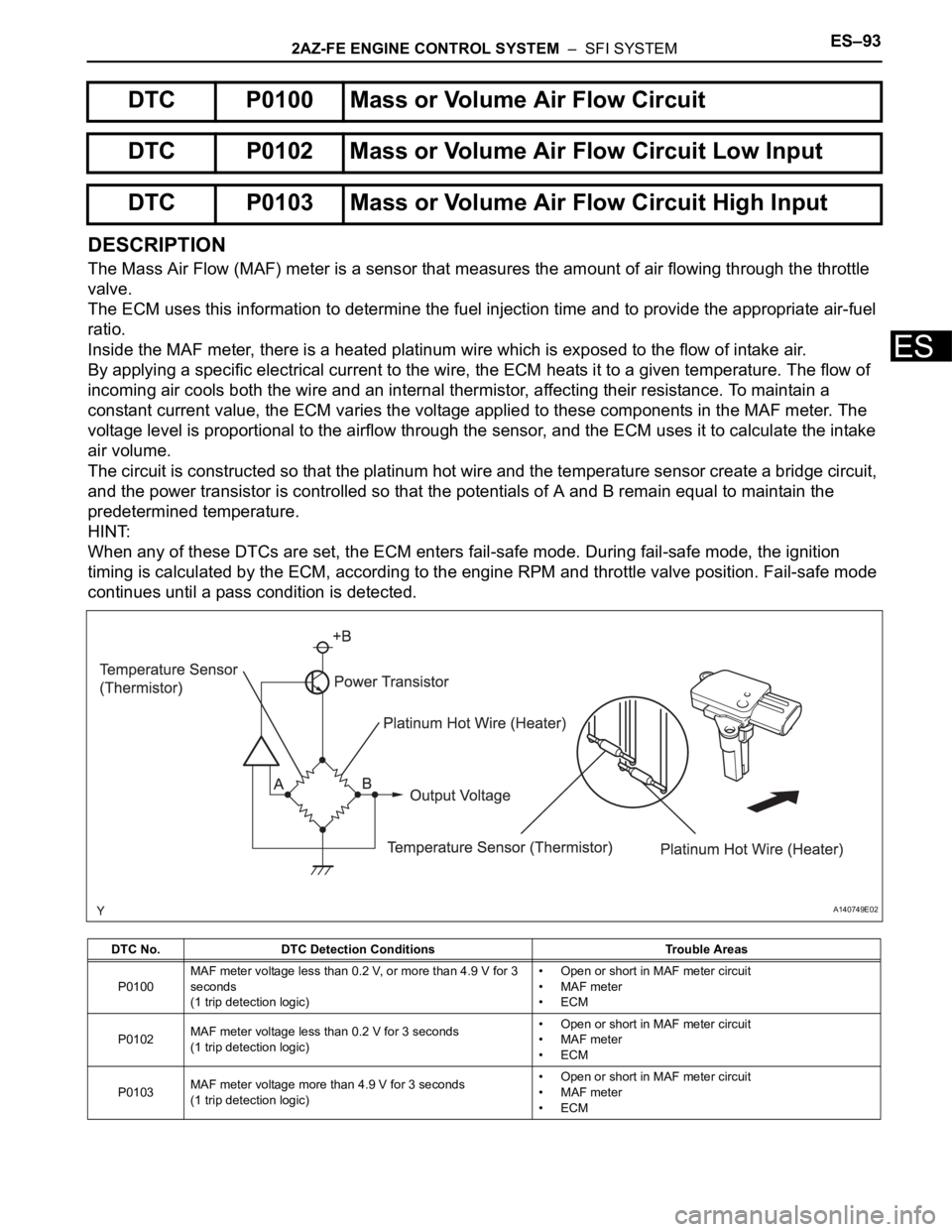
2AZ-FE ENGINE CONTROL SYSTEM – SFI SYSTEMES–93
ES
DESCRIPTION
The Mass Air Flow (MAF) meter is a sensor that measures the amount of air flowing through the throttle
valve.
The ECM uses this information to determine the fuel injection time and to provide the appropriate air-fuel
ratio.
Inside the MAF meter, there is a heated platinum wire which is exposed to the flow of intake air.
By applying a specific electrical current to the wire, the ECM heats it to a given temperature. The flow of
incoming air cools both the wire and an internal thermistor, affecting their resistance. To maintain a
constant current value, the ECM varies the voltage applied to these components in the MAF meter. The
voltage level is proportional to the airflow through the sensor, and the ECM uses it to calculate the intake
air volume.
The circuit is constructed so that the platinum hot wire and the temperature sensor create a bridge circuit,
and the power transistor is controlled so that the potentials of A and B remain equal to maintain the
predetermined temperature.
HINT:
When any of these DTCs are set, the ECM enters fail-safe mode. During fail-safe mode, the ignition
timing is calculated by the ECM, according to the engine RPM and throttle valve position. Fail-safe mode
continues until a pass condition is detected.
DTC P0100 Mass or Volume Air Flow Circuit
DTC P0102 Mass or Volume Air Flow Circuit Low Input
DTC P0103 Mass or Volume Air Flow Circuit High Input
DTC No. DTC Detection Conditions Trouble Areas
P0100MAF meter voltage less than 0.2 V, or more than 4.9 V for 3
seconds
(1 trip detection logic)• Open or short in MAF meter circuit
• MAF meter
•ECM
P0102MAF meter voltage less than 0.2 V for 3 seconds
(1 trip detection logic)• Open or short in MAF meter circuit
• MAF meter
•ECM
P0103MAF meter voltage more than 4.9 V for 3 seconds
(1 trip detection logic)• Open or short in MAF meter circuit
• MAF meter
•ECM
A140749E02
Page 1982 of 2000

ES–942AZ-FE ENGINE CONTROL SYSTEM – SFI SYSTEM
ES
HINT:
When any of these DTCs are set, check the air-flow rate by selecting the following menu items on the
intelligent tester: DIAGNOSIS / ENHANCED OBD II/ DATA LIST / PRIMARY / MAF.
MONITOR DESCRIPTION
If there is a defect in the MAF meter or an open or short circuit, the voltage level deviates from the normal
operating range. The ECM interprets this deviation as a malfunction in the MAF meter and sets a DTC.
Example:
When the sensor output voltage remains less than 0.2 V, or more than 4.9 V, for more than 3 seconds, the
ECM sets a DTC.
If the malfunction is not repaired successfully, a DTC is set 3 seconds after the engine is next started.
MONITOR STRATEGY
TYPICAL ENABLING CONDITIONS
TYPICAL MALFUNCTION THRESHOLDS
P0100:
P0102:
P0103:
COMPONENT OPERATING RANGE
Mass Air Flow Rate (g/sec.) Malfunctions
Approximately 0.0• Open in Mass Air Flow (MAF) meter power source circuit
• Open or short in VG circuit
271.0 or more • Open in E2G circuit
Related DTCsP0100: MAF meter range check (Fluctuating)
P0102: MAF meter range check (Low voltage)
P0103: MAF meter range check (High voltage)
Required Sensors/Components (Main) MAF meter
Required Sensors/Components (Related) Crankshaft position sensor
Frequency of Operation Continuous
Duration 3 seconds
MIL OperationImmediate: Engine RPM less than 4,000 rpm
2 driving cycles: Engine RPM 4,000 rpm or more
Sequence of Operation None
Monitor runs whenever following DTCs not present None
MAF meter voltage Less than 0.2 V, or more than 4.9 V
MAF meter voltage Less than 0.2 V
MAF meter voltage More than 4.9 V
MAF meter voltage Between 0.4 V and 2.2 V
Page 1983 of 2000
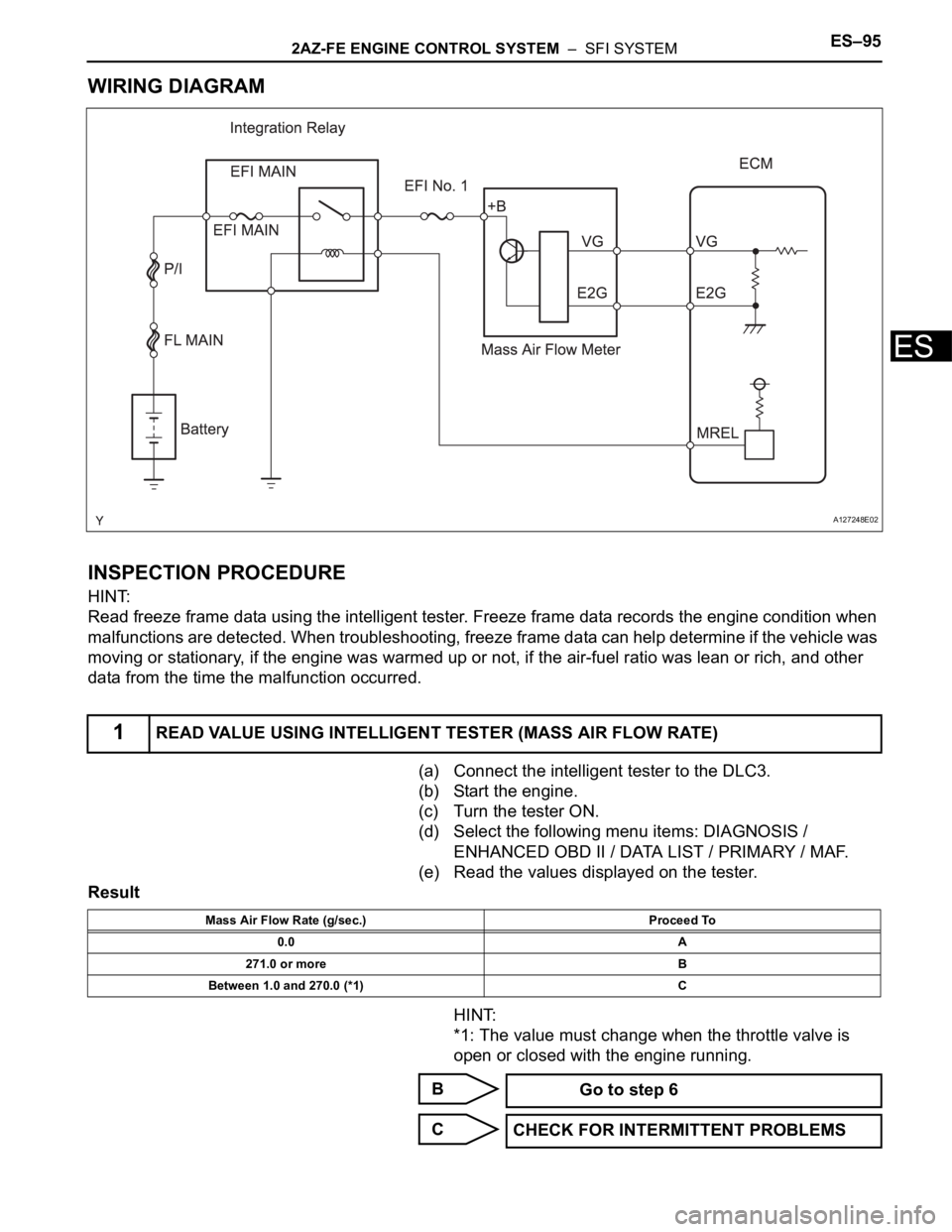
2AZ-FE ENGINE CONTROL SYSTEM – SFI SYSTEMES–95
ES
WIRING DIAGRAM
INSPECTION PROCEDURE
HINT:
Read freeze frame data using the intelligent tester. Freeze frame data records the engine condition when
malfunctions are detected. When troubleshooting, freeze frame data can help determine if the vehicle was
moving or stationary, if the engine was warmed up or not, if the air-fuel ratio was lean or rich, and other
data from the time the malfunction occurred.
(a) Connect the intelligent tester to the DLC3.
(b) Start the engine.
(c) Turn the tester ON.
(d) Select the following menu items: DIAGNOSIS /
ENHANCED OBD II / DATA LIST / PRIMARY / MAF.
(e) Read the values displayed on the tester.
Result
HINT:
*1: The value must change when the throttle valve is
open or closed with the engine running.
B
C
1READ VALUE USING INTELLIGENT TESTER (MASS AIR FLOW RATE)
A127248E02
Mass Air Flow Rate (g/sec.) Proceed To
0.0 A
271.0 or more B
Between 1.0 and 270.0 (*1) C
Go to step 6
CHECK FOR INTERMITTENT PROBLEMS
Page 1984 of 2000
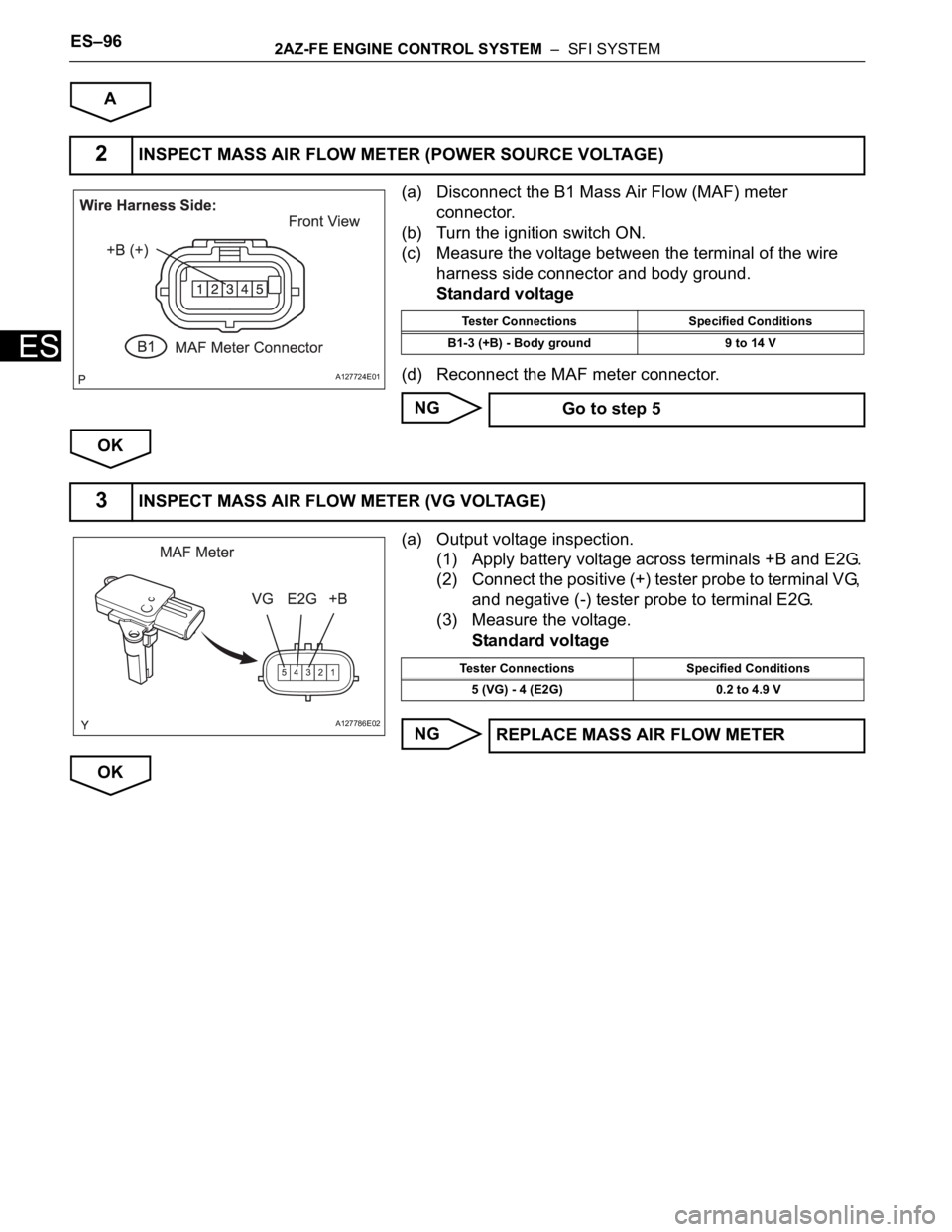
ES–962AZ-FE ENGINE CONTROL SYSTEM – SFI SYSTEM
ES
A
(a) Disconnect the B1 Mass Air Flow (MAF) meter
connector.
(b) Turn the ignition switch ON.
(c) Measure the voltage between the terminal of the wire
harness side connector and body ground.
Standard voltage
(d) Reconnect the MAF meter connector.
NG
OK
(a) Output voltage inspection.
(1) Apply battery voltage across terminals +B and E2G.
(2) Connect the positive (+) tester probe to terminal VG,
and negative (-) tester probe to terminal E2G.
(3) Measure the voltage.
Standard voltage
NG
OK
2INSPECT MASS AIR FLOW METER (POWER SOURCE VOLTAGE)
A127724E01
Tester Connections Specified Conditions
B1-3 (+B) - Body ground 9 to 14 V
Go to step 5
3INSPECT MASS AIR FLOW METER (VG VOLTAGE)
A127786E02
Tester Connections Specified Conditions
5 (VG) - 4 (E2G) 0.2 to 4.9 V
REPLACE MASS AIR FLOW METER
Page 1985 of 2000
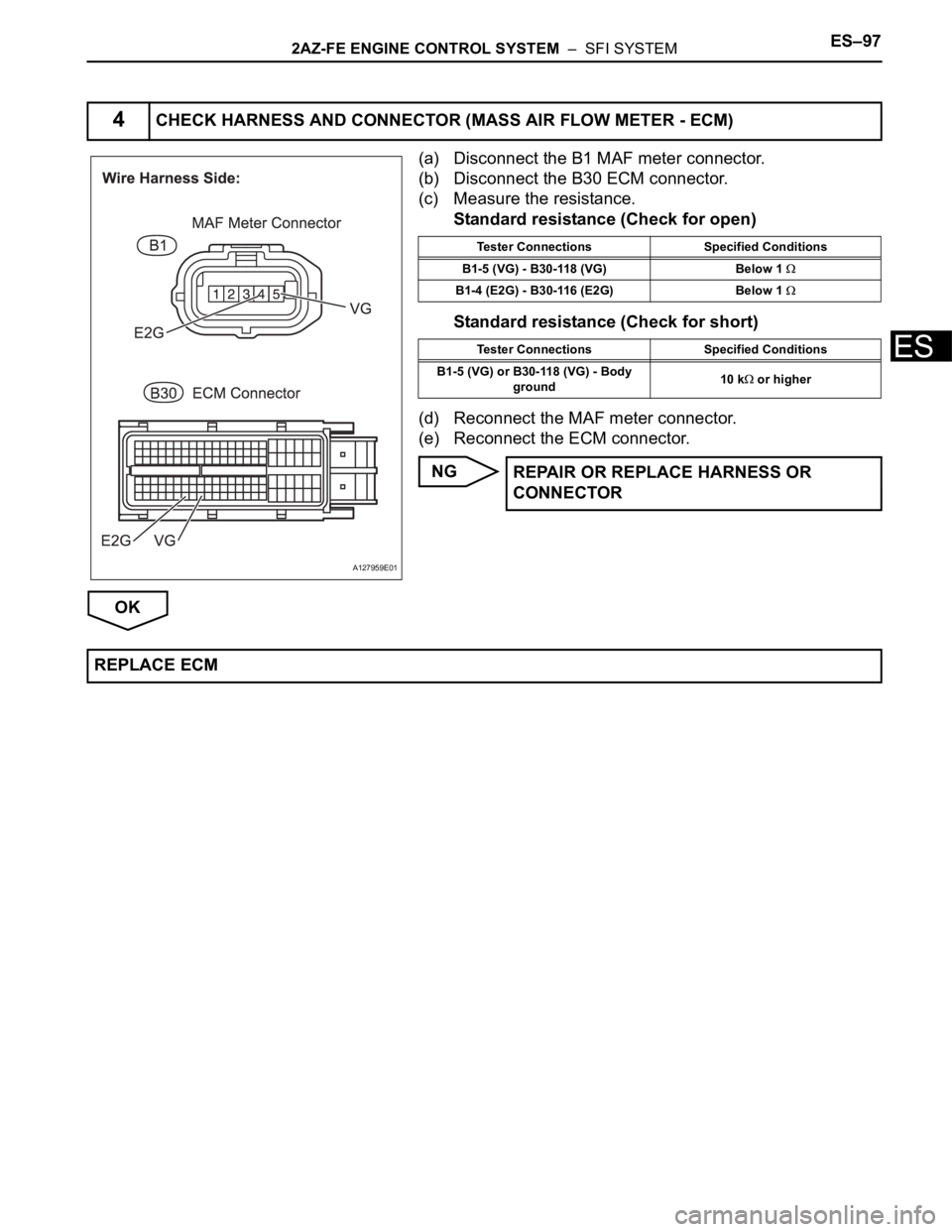
2AZ-FE ENGINE CONTROL SYSTEM – SFI SYSTEMES–97
ES
(a) Disconnect the B1 MAF meter connector.
(b) Disconnect the B30 ECM connector.
(c) Measure the resistance.
Standard resistance (Check for open)
Standard resistance (Check for short)
(d) Reconnect the MAF meter connector.
(e) Reconnect the ECM connector.
NG
OK
4CHECK HARNESS AND CONNECTOR (MASS AIR FLOW METER - ECM)
A127959E01
Tester Connections Specified Conditions
B1-5 (VG) - B30-118 (VG) Below 1
B1-4 (E2G) - B30-116 (E2G) Below 1
Tester Connections Specified Conditions
B1-5 (VG) or B30-118 (VG) - Body
ground10 k
or higher
REPAIR OR REPLACE HARNESS OR
CONNECTOR
REPLACE ECM
Page 1986 of 2000
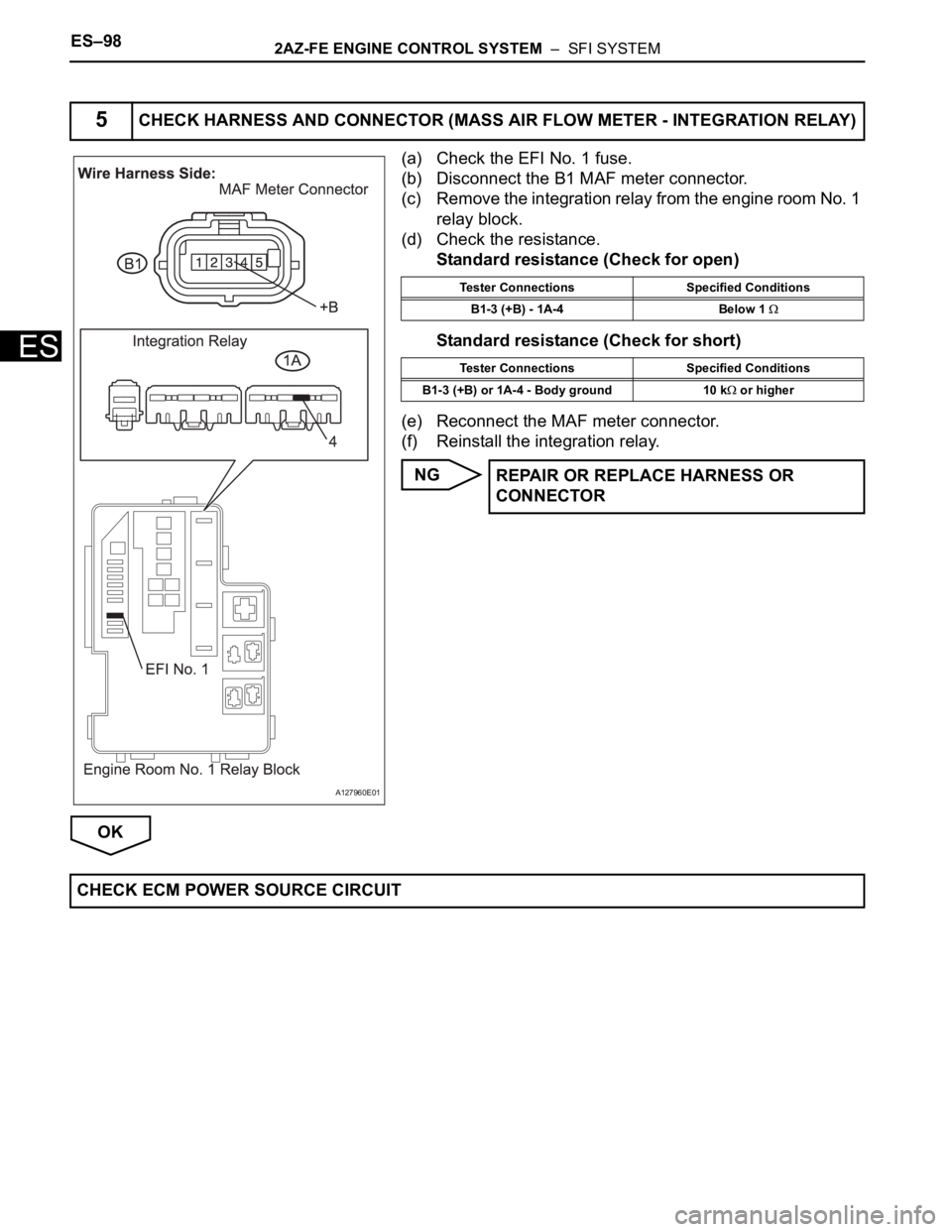
ES–982AZ-FE ENGINE CONTROL SYSTEM – SFI SYSTEM
ES
(a) Check the EFI No. 1 fuse.
(b) Disconnect the B1 MAF meter connector.
(c) Remove the integration relay from the engine room No. 1
relay block.
(d) Check the resistance.
Standard resistance (Check for open)
Standard resistance (Check for short)
(e) Reconnect the MAF meter connector.
(f) Reinstall the integration relay.
NG
OK
5CHECK HARNESS AND CONNECTOR (MASS AIR FLOW METER - INTEGRATION RELAY)
A127960E01
Tester Connections Specified Conditions
B1-3 (+B) - 1A-4 Below 1
Tester Connections Specified Conditions
B1-3 (+B) or 1A-4 - Body ground 10 k
or higher
REPAIR OR REPLACE HARNESS OR
CONNECTOR
CHECK ECM POWER SOURCE CIRCUIT
Page 1987 of 2000
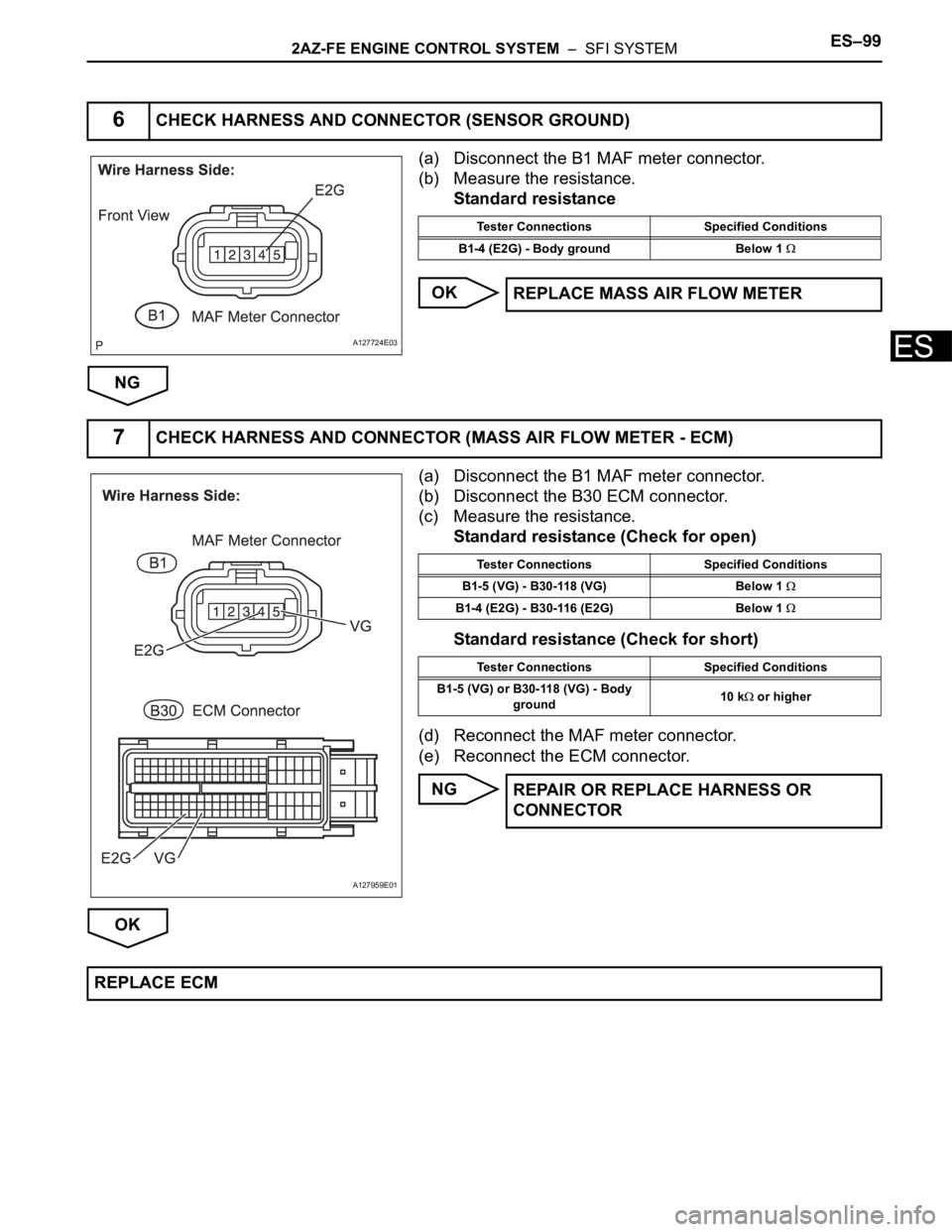
2AZ-FE ENGINE CONTROL SYSTEM – SFI SYSTEMES–99
ES
(a) Disconnect the B1 MAF meter connector.
(b) Measure the resistance.
Standard resistance
OK
NG
(a) Disconnect the B1 MAF meter connector.
(b) Disconnect the B30 ECM connector.
(c) Measure the resistance.
Standard resistance (Check for open)
Standard resistance (Check for short)
(d) Reconnect the MAF meter connector.
(e) Reconnect the ECM connector.
NG
OK
6CHECK HARNESS AND CONNECTOR (SENSOR GROUND)
A127724E03
Tester Connections Specified Conditions
B1-4 (E2G) - Body ground Below 1
REPLACE MASS AIR FLOW METER
7CHECK HARNESS AND CONNECTOR (MASS AIR FLOW METER - ECM)
A127959E01
Tester Connections Specified Conditions
B1-5 (VG) - B30-118 (VG) Below 1
B1-4 (E2G) - B30-116 (E2G) Below 1
Tester Connections Specified Conditions
B1-5 (VG) or B30-118 (VG) - Body
ground10 k
or higher
REPAIR OR REPLACE HARNESS OR
CONNECTOR
REPLACE ECM
Page 1988 of 2000

ES–1002AZ-FE ENGINE CONTROL SYSTEM – SFI SYSTEM
ES
DESCRIPTION
Refer to DTC P0100 (see page ES-86).
MONITOR DESCRIPTION
The MAF meter is a sensor that measures the amount of air flowing through the throttle valve. The ECM
uses this information to determine the fuel injection time and to provide an appropriate air-fuel ratio. Inside
the MAF meter, there is a heated platinum wire which is exposed to the flow of intake air. By applying a
specific electrical current to the wire, the ECM heats it to a specific temperature. The flow of incoming air
cools both the wire and an internal thermistor, affecting their resistance. To maintain a constant current
value, the ECM varies the voltage applied to these components of the MAF meter. The voltage level is
proportional to the airflow through the sensor, and the ECM uses it to calculate the intake air volume.
The ECM monitors the average engine load value ratio to check the MAF meter for malfunctions. The
average engine load value ratio is obtained by comparing the average engine load calculated from the
MAF meter output to the average engine load estimated from the driving conditions, such as the engine
speed and the throttle opening angle. If the average engine load value ratio is below the threshold value,
the ECM determines that the intake air volume is low, and if the average engine load value ratio is above
the threshold value, the ECM determines that the intake air volume is high.
If this is detected in 2 consecutive driving cycles, the MIL is illuminated and a DTC is set.
MONITOR STRATEGY
TYPICAL ENABLING CONDITIONS
DTC P0101Mass Air Flow Circuit Range / Performance
Problem
DTC No. DTC Detection Conditions Trouble Areas
P0101Conditions (a), (b), (c), (d) and (e) continue for more than 10
seconds (2 trip detection logic):
(a) Engine running
(b) Engine coolant temperature 70
C (158F) or higher
(c) Throttle Position (TP) sensor voltage 0.24 V or more
(d) Average engine load value ratio less than 0.85, or more
than 1.15 (varies with estimated engine load)
Average engine load value ratio = Average engine load based
on MAF meter output / Average engine load estimated from
driving conditions
(e) Average air-fuel ratio less than -20 %, or more than 20 %• Mass Air Flow (MAF) meter
• Air induction system
• PCV hose connections
Related DTCs P0101: Mass air flow meter rationality
Required Sensors/Components (Main) Mass air flow meter
Required Sensors/Components (Related)Crankshaft Position (CKP) sensor, Engine Coolant Temperature
(ECT) sensor and Throttle Position (TP) sensor
Frequency of Operation Continuous
Duration 10 seconds
MIL Operation 2 driving cycles
Sequence of Operation None
Monitor runs whenever following DTCs not presentP0115 - P0118 (ECT sensor)
P0120 - P0223, P2135 (TP sensor)
P0125 (Insufficient ECT for closed loop)
P0335 (CKP sensor)
P0340 (CMP sensor)
Throttle position (TP sensor voltage) 0.24 V or more
Engine Running
Battery voltage 10.5 V or more
Page 1989 of 2000
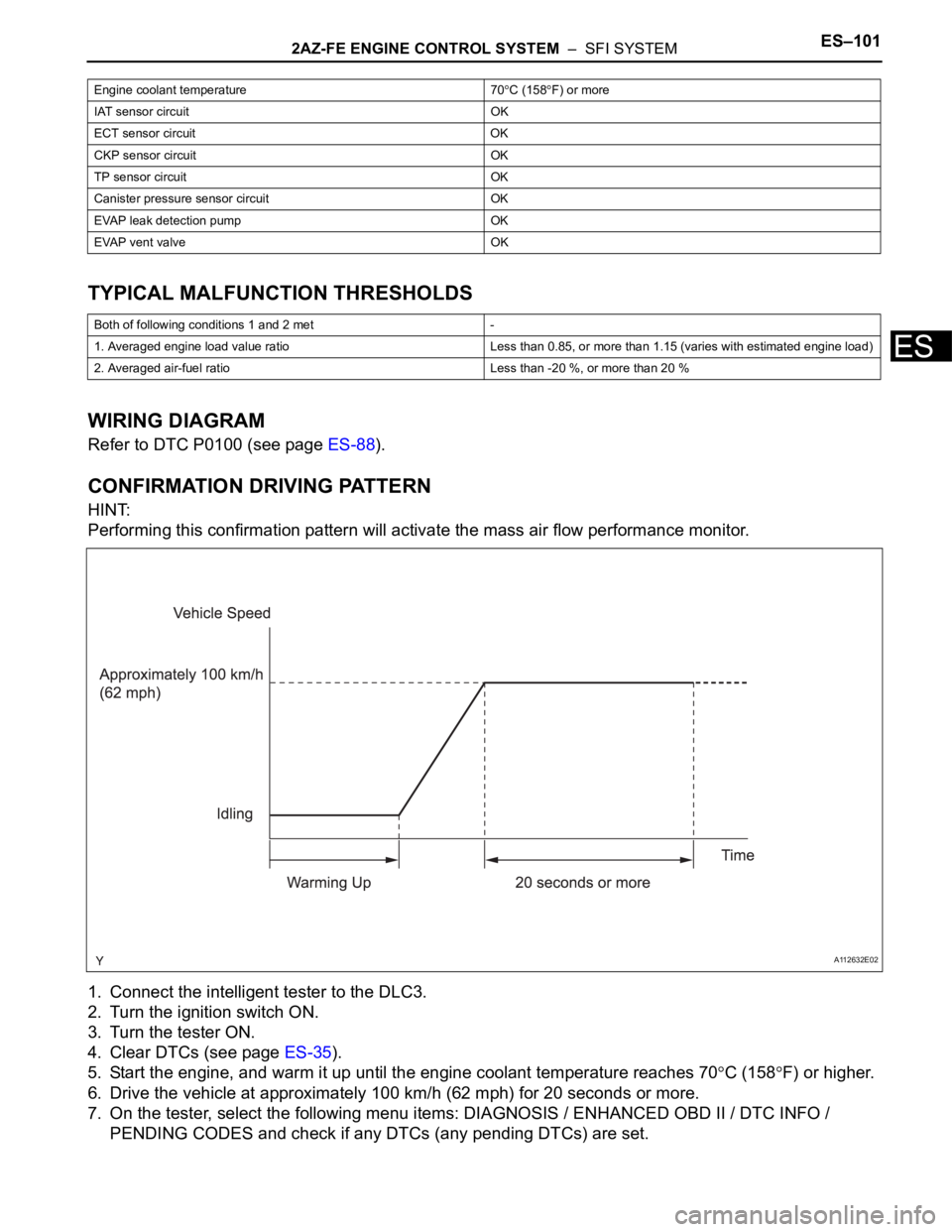
2AZ-FE ENGINE CONTROL SYSTEM – SFI SYSTEMES–101
ES
TYPICAL MALFUNCTION THRESHOLDS
WIRING DIAGRAM
Refer to DTC P0100 (see page ES-88).
CONFIRMATION DRIVING PATTERN
HINT:
Performing this confirmation pattern will activate the mass air flow performance monitor.
1. Connect the intelligent tester to the DLC3.
2. Turn the ignition switch ON.
3. Turn the tester ON.
4. Clear DTCs (see page ES-35).
5. Start the engine, and warm it up until the engine coolant temperature reaches 70
C (158F) or higher.
6. Drive the vehicle at approximately 100 km/h (62 mph) for 20 seconds or more.
7. On the tester, select the following menu items: DIAGNOSIS / ENHANCED OBD II / DTC INFO /
PENDING CODES and check if any DTCs (any pending DTCs) are set.
Engine coolant temperature 70C (158F) or more
IAT sensor circuit OK
ECT sensor circuit OK
CKP sensor circuit OK
TP sensor circuit OK
Canister pressure sensor circuit OK
EVAP leak detection pump OK
EVAP vent valve OK
Both of following conditions 1 and 2 met -
1. Averaged engine load value ratio Less than 0.85, or more than 1.15 (varies with estimated engine load)
2. Averaged air-fuel ratio Less than -20 %, or more than 20 %
A112632E02
Page 1990 of 2000
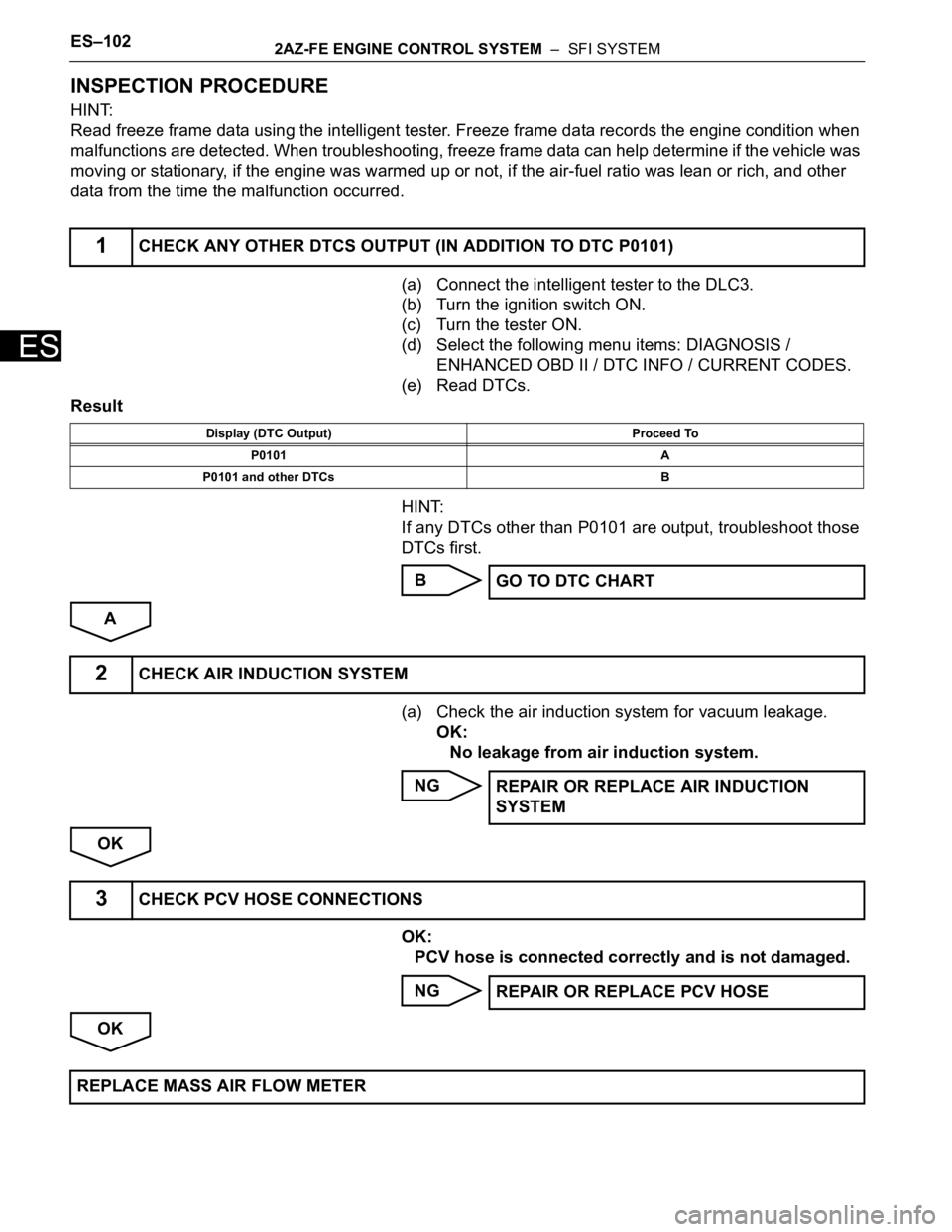
ES–1022AZ-FE ENGINE CONTROL SYSTEM – SFI SYSTEM
ES
INSPECTION PROCEDURE
HINT:
Read freeze frame data using the intelligent tester. Freeze frame data records the engine condition when
malfunctions are detected. When troubleshooting, freeze frame data can help determine if the vehicle was
moving or stationary, if the engine was warmed up or not, if the air-fuel ratio was lean or rich, and other
data from the time the malfunction occurred.
(a) Connect the intelligent tester to the DLC3.
(b) Turn the ignition switch ON.
(c) Turn the tester ON.
(d) Select the following menu items: DIAGNOSIS /
ENHANCED OBD II / DTC INFO / CURRENT CODES.
(e) Read DTCs.
Result
HINT:
If any DTCs other than P0101 are output, troubleshoot those
DTCs first.
B
A
(a) Check the air induction system for vacuum leakage.
OK:
No leakage from air induction system.
NG
OK
OK:
PCV hose is connected correctly and is not damaged.
NG
OK
1CHECK ANY OTHER DTCS OUTPUT (IN ADDITION TO DTC P0101)
Display (DTC Output) Proceed To
P0101 A
P0101 and other DTCs B
GO TO DTC CHART
2CHECK AIR INDUCTION SYSTEM
REPAIR OR REPLACE AIR INDUCTION
SYSTEM
3CHECK PCV HOSE CONNECTIONS
REPAIR OR REPLACE PCV HOSE
REPLACE MASS AIR FLOW METER